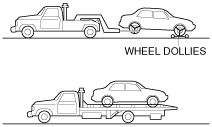TOWING
id000000800600
• Proper lifting and towing are necessary to prevent damage to the vehicle.
Particularly when towing a 4WD vehicle, where all the wheels are connected to the drive train, proper transporting of the vehicle is absolutely essential to avoid damaging the drive system. Government and local laws must be followed.
• A towed 4WD vehicle must have all its wheels off the ground.
-
Caution
-
• Do not tow the vehicle pointed backward with driving wheels on the ground. This may cause internal damage to the transaxle.
-
Caution
-
• Do not tow with sling-type equipment. This could damage your vehicle. Use wheel-lift or flatbed equipment.
-
Warning
-
• Always tow a 4WD vehicle with all four wheels off the ground:
Towing a 4WD vehicle with either the front or rear wheels on the ground is dangerous as the drive train could be damaged, or the vehicle could trail away from the tow truck and cause an accident. If the drive train has been damaged, transport the vehicle on a flat bed truck.
Tiedown Hooks
-
Caution
-
• Don't use the tiedown hooks under the front and rear for towing.
They are designed ONLY for tying down the vehicle when it's being transported. Using them for towing will damage the bumper.
1. Wrap a screwdriver or similar tool with a soft cloth to prevent damage to the painted bumper and open the cap located on the front bumper.
-
Caution
-
• The cap cannot be completely removed. Do not use excessive force as it may damage the cap or scratch the painted bumper surface.
2. Securely install the towing eyelet using the lug wrench.
3. Hook the towing rope to the towing eyelet.
-
Caution
-
• If the towing eyelet is not securely tightened, it may loosen or disengage from the bumper when towing the vehicle. Make sure that the towing eyelet is securely tightened to the bumper.
